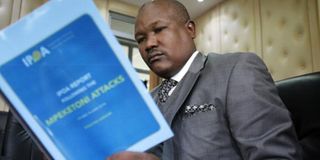David Kimaiyo given 90 days to reshape police command

Independent Policing Oversight Authority board member Tom Kagwe during the release of the Mpeketoni attack report on October 6, 2014. PHOTO | EVANS HABIL |
What you need to know:
- Ipoa says the current structure is disjointed and blames it for the disorderly response by various units.
- Within the 90 days, the IG should also respond to other issues Ipoa has raised.
Police chief David Kimaiyo has three months to reorganise the command of the National Police Service (NPS) to make it more co-ordinated and responsive.
In a report on the Mpeketoni killings released on Monday, the Independent Policing Oversight Authority (Ipoa) says the current structure is disjointed and blames it for the disorderly response by various units, which resulted in the killing of 60 people.
“The Inspector-General should appoint a single NPS county commander in each of the 47 counties to coordinate effective policing by officers in units,” the report by the civilian oversight body says.
RESPOND TO ISSUES
A county commander will oversee all police units, including the Administration Police, Kenya Police, Directorate of Criminal Investigations and the General Service Unit “to ensure there is no doubt as regards command at all levels”.
Section 10 of the National Police Service Act mandates the IG with providing the command structure and system for the efficient administration of the service nationally.
Within the 90 days, the IG should also respond to other issues Ipoa has raised.
The report seeks to know why the Kenya Police and the Administration Police officers, who were expected to be on night patrol in Mpeketoni, did not report to work at the time of the attacks.
There are also proposals that if implemented, Ipoa feels in the event of similar future attacks, the police response would be above board.
In the course of investigations, police officers told Ipoa that many of them had not fired their weapons for a long time, and were thus ill-prepared to counter the attackers.
This is goes against the Service Standing Orders that calls for regular arms drills by all officers.
The report cited chapter 31 of the SSO, which says: “All ranks will fire an annual course with the weapon they normally use. In addition, regular and frequent weapon training will be held.”




